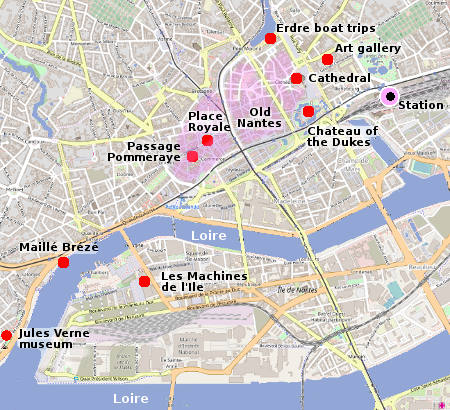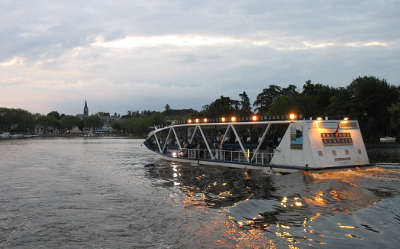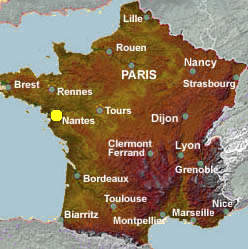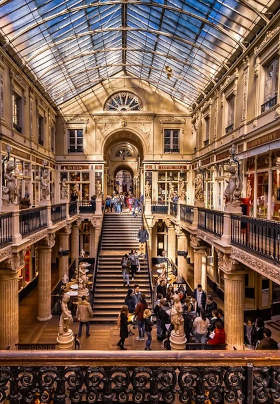
Nantes - city and visitor guide
Historic city of the Dukes of Brittany
- Explore France ►
- Essential pages
- Travel in France
- Where to go
- What to see and do
About-France.com
- the connoisseur's guide to France
Nantes - the hub of western France
| On this page | Location and access | Tourist attractions |
| In the area | Local accommodation |

Central Nantes.
Until the nineteenth century, Nantes was one of the most important port cities in France. In the Middle Agers, it was one of France's greatest ports for trade with other parts of Europe, notably with England and Portugal ; later it was the gateway to North America, the port through which came in and went out a good proportion of France's international trade, not just with Canada, Acadia and the nascent USA, but also with the Caribbean and other parts of the world.
And then ships got bigger and railways made land transport faster and easier and Nantes, just like Bristol in the UK, found itself "up the creek", too far inland along a tidal estuary to meet the new demands of international shipping. And, as with Bristol or even - more recently - London and other cities, Nantes' riverside port activity dwindled and the city's economic significance fell, as business moved downstream, in this case to Saint Nazaire, at the mouth of the Loire.
By that time however, Nantes was already too strongly established as a city, and too big, to fade away. In bygone centuries, the city that stood guard over the lowest bridging point across the Loire had been the capital of the powerful Dukes of Brittany, and the city had grown up around their massive fortress close to the water's edge, the chateau des Ducs de Bretagne. Later, as France became one of the great colonial powers of Europe, trade brought great wealth to the city which grew in size and influence. The merchants of Nantes, like their counterparts throughout the great European port cities of the time, were active in the slave trade with the Americas, which was one of the businesses that enriched the city in the 18th century, until after the French Revolution when in 1794 France was the first European nation to ban slavery in all its dominions.

Panoramic
view of the Place Royale in the centre of Nantes
Apart from its medieval / Renaissance castle, which now houses the city's museum, and the late medieval cathedral of St. Peter and St.Paul, the historic centre of Nantes is largely characterised by streets and buildings that were put up in the period of the city's commercial heyday, from the late 17th century to the early 19th century. This helps to give Nantes a slight Parisian feeling - like a small version of Paris in the west of France.
The once busy port area of Nantes is now very quiet; the little commercial shipping that still comes up the Loire as far as Nantes uses wharves on the south side of the Loire or on the western outskirts of the city, and the few cruise liners that make it up the Loire estuary have to dock well away from the centre. The Quai de la Fosse, closest to the city centre, has no commercial shipping, but is served by pleasure craft and is home to some historic ships, including the Maillé-Brézé, a historic warship and naval museum.
Today, more than a port, Nantes is the administrative and commercial hub of northwestern France. The city that was until the 16th century the capital of Brittany is now no longer part of Brittany; the department of Loire Atlantique, of which it is the capital, was definitively hived off from Brittany under the Vichy government during the second world war, and has since become the capital of a new administrative region - with little historic basis - the Pays de la Loire, created in 1963. In that respect, Nantes remains a regional capital... but no longer the capital of Brittany. That is now Rennes.
Tourist attractions in Nantes
Nantes is a big city, but its historic central area is compact enough to be discovered on foot. or by taking the city's smart modern trams. the main tourist attractions are :
- The Chateau of the Dukes of Brittany - a renovated medieval castle which today includes the history museum.
- The cathedral - Although it is not regarded as one of France's greatest cathedrals, the late medieval gothic cathedral at Nantes is impressive, particularly on the inside. It is the sixth tallest cathedral in France. Damaged during the second world war, and later by a fire in the 1970s, it has been fully renovated to its early splendour.
-
The river Erdre. a boat trip or a dinner cruise on the Erdre is a must. Trips take visitors ten to fifteen kilometres up the river, which is bordered on either side by an impressive number of small châteaux and manor houses built for rich merchants at the time of Nantes' great prosperity.

Dinner cruise on the Erdre - The Nantes Art Gallery. In terms of the range of its collection, this is one of the better provincial art galleries in France. It includes works by Bernardo Daddi, Breughel the elder, de Latour, Perugino, Tintoretto, Ingres, Burne-Jones, Corot, Monet, Sisley, Picasso and many more.
- Place Royale. the grand urban piazza dating from the late eighteenth century, when the prosperity of the city was at its peak. Now part of the pedestrian area of central Nantes, the piazza is popular for its cafés and shops.
- Passage Pommeraye. A fine 19th century covered shopping arcade, decorated with classical statues, and home to many up-market stores and boutiques.
- Maillé-Brézé. A T47 class naval destroyer, decommissioned in 1988, the Maillé-Brézé is now a museum ship. She was temporarily absent from Nantes in the spring of 2016, when she was used in the film Dunkirk.
- Jules Verne museum. Museum devoted to the life and work of the great 19th century writer and traveller, author of Around the World in Eighty Days and many other popular novels
- Les Machines
de l'Ile. Popular family destination, a museum
filled with fantastic modern machines, including a mechanical walking
elephant that carries passengers on a ride round the site. Website.
Places to visit near Nantes

Salterns or salt pans near
Guérande
The Loire Atlantique department, around Nantes, covers the western end of this region, including the estuary of the Loire and the coast to the north and the south.
- La Boissière Doré zoo 40 km east of Nantes. Small safari park - 20 hectares and 70 species. Involved in the breeding of endangered species, notably orang-utangs.
- Planète Sauvage - 20 km southwest of Nantes. One of the largest safari parks in France, covering about 180 acres or 80 hectares.
- The Château de Goulaine, A small Loire valley château and vineyard that is reputedly the oldest family-owned business in Europe. Today the castle is also home to a large butterfly houe and to the Lu Biscuits museum, Lu being a historic French brand in the same way as MacVities in the UK.
- Abbey church of St Philibert de Grandlieu. 30 km south of Nantes. One of the oldest churches in France, the nave dating from the time of Charlemagne (9th century) . Decorative stone and brickwork in the Roman style.
- The Jade Coast - attractive coastline to the south of the mouth of the Loire, around the small seaside resort of Pornic.
- Guérande. Small medieval town still enclosed in ramparts. the town is a popular tourist destination, and is particularly know for its historic salt industry. Guérande natural sea salt, le Sel de Guérande, is sold in delicatessens and specialist outlets throughout France and well beyond.
- La Baule, Le Crosic, Pornichet. Popular seaside resorts just to the north of the Loire estuary. La Baule was created from nothing in the late 19th century as an up-market seaside resort for Parisians. Today it is known, like Cannes or Deauville, for its casino, its four and five-star hotels and its film festival.
Accommodation
Click here for a ► choice of hotels in Nantes at best online rates, and the About-France.com hotel selection for Nantes.There is plenty of hotel accommodation in Nantes.
Location and access
- By air Nantes airport is served by direct flights from a dozen or so airports in the UK and Ireland For details see Fly to France.
- By train Nantes is accessible by direct high-speed trains from Paris Gare Montparnasse in about two hours. Timetables and tickets
- By car Nantes can be reached by car from Calais in 6 hours, via Rouen and Le Mans, and in just over 4 hours from Le Havre, via Caen and Rennes.
About-France.com
Home page -
Site search
- Regions
- Maps of France
- Contact
Photo
top of page : the château of the Dukes of
Brittany

or
Four star boutique hotel in a converted 19th century church, close to the château, the art gallery and the cathedral. Private parking - charge.
★★★★ Hotel Mercure Nantes gare
Just outside the south exit from the station, beside the Quai Malakoff. Pedestrian access to the château and old town.
★★★ Ibis Nantes centre gare
Close to the Château and to the station and old town. Private parking onsite. charge.
★★ Hotel Abat-Jour
Well reviewed small two-star hotel close to the Erdre wharf and the cathedral. Public parking nearby. Charge.
★ Hotel Cambronne
Very well rated centrally located one-star hotel, between Passage Pommeraye and the Loire. Public parking very near. Charge.

Passage Pommeraye - 19th century shopping arcade in Nantes
Copyright © About-France.com 2007 - 2025 except
Photo panorama of Place Royale by Ludovic Toinel - Chateau des Ducs de Bretagne by Elie Metayer. Passage Pommeraye by Edmondlaphoto.
Creative commons licence.
Key
tourist information for Nantes :
Region: Pays de la Loire
Nearby cities: Rennes, Angers
Nearest airports: Nantes
Population: (Greater Nantes) 612,000
Main sites: The château of the Dukes of Brittany, the city art gallery, historic city centre, the cathedral, boat trips on the Erdre
Nearby attractions: The Loire estuary, the Atlantic coast, La Baule
Region: Pays de la Loire
Nearby cities: Rennes, Angers
Nearest airports: Nantes
Population: (Greater Nantes) 612,000
Main sites: The château of the Dukes of Brittany, the city art gallery, historic city centre, the cathedral, boat trips on the Erdre
Nearby attractions: The Loire estuary, the Atlantic coast, La Baule

Nantes hotels
or
The About-France.com selection
Hotels for all budgets and all needs
★★★★ Okko
hotel Nantes chateauHotels for all budgets and all needs
Four star boutique hotel in a converted 19th century church, close to the château, the art gallery and the cathedral. Private parking - charge.
★★★★ Hotel Mercure Nantes gare
Just outside the south exit from the station, beside the Quai Malakoff. Pedestrian access to the château and old town.
★★★ Ibis Nantes centre gare
Close to the Château and to the station and old town. Private parking onsite. charge.
★★ Hotel Abat-Jour
Well reviewed small two-star hotel close to the Erdre wharf and the cathedral. Public parking nearby. Charge.
★ Hotel Cambronne
Very well rated centrally located one-star hotel, between Passage Pommeraye and the Loire. Public parking very near. Charge.
About-France.com
is an independent user-supported website, and
may receive commission from sales made
on selected partner websites accessible through
affiliate links.

Passage Pommeraye - 19th century shopping arcade in Nantes
Copyright © About-France.com 2007 - 2025 except
Photo panorama of Place Royale by Ludovic Toinel - Chateau des Ducs de Bretagne by Elie Metayer. Passage Pommeraye by Edmondlaphoto.
Creative commons licence.
Click here for
low-cost car hire in France
low-cost car hire in France
